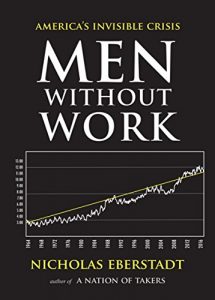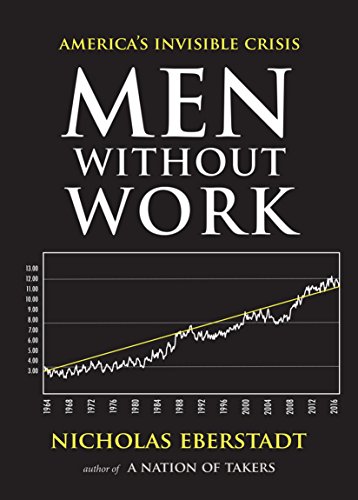 Nicholas Eberstadt of American Enterprise Institute provides helpful insight into an issue that “after capitalism” is going to need to address: lack of jobs, or to extend forward, imagining a world without work. He specifically focuses on the current prospects of a significant portion of men in Men Without Work: America’s Invisible Crisis. The book provides lots of useful data on why many men have essentially given up on finding work. To get a handle on the issue: “Between the early 1950s and today, the work rate for adult men has plummeted by more than eighteen percentage points.” And “the percent of economically inactive men of prime working age leapt from 3.4% in 1965 to 11.8% in 2015.
Nicholas Eberstadt of American Enterprise Institute provides helpful insight into an issue that “after capitalism” is going to need to address: lack of jobs, or to extend forward, imagining a world without work. He specifically focuses on the current prospects of a significant portion of men in Men Without Work: America’s Invisible Crisis. The book provides lots of useful data on why many men have essentially given up on finding work. To get a handle on the issue: “Between the early 1950s and today, the work rate for adult men has plummeted by more than eighteen percentage points.” And “the percent of economically inactive men of prime working age leapt from 3.4% in 1965 to 11.8% in 2015.
Some of the explanations he offers suggest social and structural issues in employment (although he is not making an “after capitalism” case).
- Adult work rates never recovered entirely after the 2001 recession. Interestingly, the recovery after each recession includes a smaller percentage of working males (basically, fewer find their way back to work)
- Another factor is that the upsurge of employment for women disguised the steady decline in work for men. (because it makes overall employment rates look better)
- Educational attainment dramatically affects the odds that a prime-age male in 2015 would be holding down a job or living as an un-worker.
- Having a criminal record is a key missing piece in explaining why work rates have collapsed much more dramatically in America than other affluent Western societies
- Yet another issue is presented by the post-Cold War reduction in the size of the U.S. military.
- The problem perpetuates itself: experiments have found that employers across a wide range of fields and occupations were much more reluctant to offer an interview to a man who had been out of a job more than six months
He suggests they are getting by relying on income from spouses and other family members, disability payments, and forms of welfare.
There is some national “denial” going on. He includes several quotes along these lines suggesting that the men problem is “hidden,” such as:
- “The American economy is in good shape . . . we are essentially at full employment . . . tight labor markets are leading to increases in hourly earnings and in the producer prices of services.” (Martin Feldstein)
The problem of the discouraged worker gets to the heart of this. People who say they are discouraged are counted as out of the labor force. Steady, ongoing exodus from the labor force, the economically inactive have come to eclipse the unemployed as the main category of men without jobs (p. 41).
The author, to his credit, also includes critiques of the book at the end. One critique in particular makes good sense to me: “As for the causes of the American male’s flight from work—an ancient left/right argument—[the author] believes welfare benefits, disability, and criminal justice factors play critical roles, and gives them more weight than demand-side factors.”
For our project, a primary contribution of this book is that it supports the notion idea that if we probe beneath the surface, we find that the neoliberal capitalist “baseline” future is in more trouble than conventional wisdom suggests. And our tendency will be to pretend things are okay rather than deal with the harsh reality. – Andy Hines

The problem is contributing to the decline of rural areas. Jobs and businesses are quickly migrating to cities which have more resources, and increasingly more customers. Rural logistics hubs are closing down. Housing price differentials are preventing families from moving to where the jobs are. Failure of telcos to fulfill their promise of providing broadband to rural areas has stifled competitiveness further amplifying rural flight. Even the opioid epidemic is strongly linked to loss of “real” jobs by older men. The Wall Street Journal is running a good series of articles discussing all of this (ONE NATION, DIVISIBLE). One of the articles: https://www.wsj.com/articles/rural-america-is-the-new-inner-city-1495817008